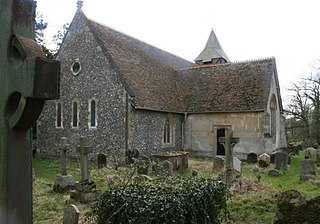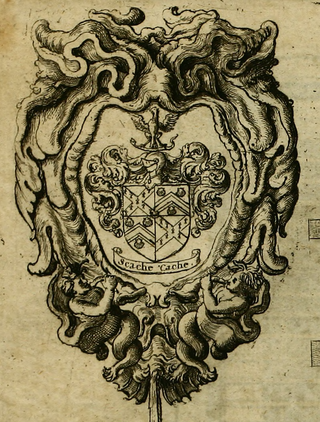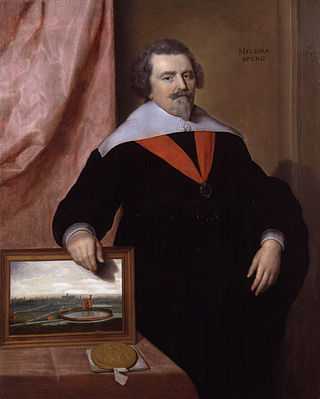
Sir John Wildman was an English politician and soldier.

Earl of Clarendon is a title that has been created twice in British history, in 1661 and 1776.

Hurst is a village in the civil parish of St Nicholas Hurst in the Borough of Wokingham, Berkshire, England. The village lies between Twyford and Wokingham, about 1.5 miles (2.4 km) north of the M4 motorway.

Barkham is a village and civil parish in the borough of Wokingham in Berkshire, England, located around 2 miles (3.2 km) southwest of the town of Wokingham.

Finchampstead is a village and civil parish in the Wokingham Borough in the shire of Berkshire, England. Its northern extremity is 2 miles (3 km) south of Wokingham, 5 miles (8 km) west of Bracknell, 8 miles (13 km) south-east of Reading, and 34 miles (55 km) west of Central London. It is an affluent area, with the village ranking as Britain's 31st wealthiest. It has a high standard of living and is rated as one of the most desirable places to live in the United Kingdom.

Henry Hyde, 2nd Earl of Clarendon, PC was an English aristocrat and politician. He held high office at the beginning of the reign of his brother-in-law, King James II.

Three Mile Cross is a village in the Borough of Wokingham, Berkshire, England, around 3 miles (4.8 km) to the south of Reading town centre. Along with the adjoining village of Spencers Wood to the south, it forms a part of the civil parish of Shinfield.

William Talman (1650–1719) was an English architect and landscape designer.

Swallowfield is a village and civil parish in Berkshire, England, about 5 miles (8 km) south of Reading, and 1 mile (1.6 km) north of the county boundary with Hampshire.

Dinton is a village, civil parish and former manor in Wiltshire, England, in the Nadder valley on the B3089 road about 8 miles (13 km) west of Salisbury. The parish population was 696 at the 2011 census, estimated at 733 in 2019. The civil parish includes the village of Baverstock, about 1 mile (1.6 km) east of Dinton village.

William Backhouse was an English philosopher, alchemist, astrologer, translator, and the esoteric mentor of Elias Ashmole.
Sir Henry Russell, 1st Baronet was a British lawyer. He was made a Privy Counsellor in 1816, during the reign of George III. The Russell baronetcy of Swallowfield in Berkshire, was created in the Baronetage of the United Kingdom on 10 December 1812 for him. Russell was the Chief Justice of Bengal.
Beaumys Castle, also known as Beams Castle, was a 14th-century fortified manor house in the parish of Swallowfield in the English county of Berkshire.

Samuel Backhouse was an English merchant who later became a country gentleman based in the county of Berkshire. He was a member of Parliament (MP) twice early in James I's reign, first for New Windsor in 1604 and then for Aylesbury in 1614.

Sir John Backhouse, KB was an English landowner and politician who sat in the House of Commons from 1625 to 1629. He supported the Royalist cause in the English Civil War.

Foliejon Park is a manorial country house in the civil parish of Winkfield in the English county of Berkshire. The building has been listed as Grade II since 7 December 1966 and was the temporary residence of King Haakon VII during the Nazi occupation of Norway.
Villiers is an aristocratic family in the United Kingdom. Over time, various members of the Villiers family were made knights, baronets, and peers. Peerages held by the Villiers family include the dukedoms of Buckingham (1623–1687) and Cleveland (1670–1709), as well as the earldoms of Anglesey (1623–1661), Jersey, and Clarendon. Perhaps the most prominent members of the family were those who received the two dukedoms: George Villiers, 1st Duke of Buckingham (1592–1628) rose to fame and influence as favourite of King James I of England, while Barbara Villiers, Duchess of Cleveland (1640–1709) became a mistress of King Charles II of England, by whom she had five children.

Flower Backhouse, Countess of Clarendon was an English courtier, notable as First Lady of the Bedchamber to Princess Anne, the future Queen Anne of Great Britain. She was Countess of Clarendon from 1670 until her death.

Coleshill House was a country house in England, near the village of Coleshill, in the Vale of White Horse. Historically, the house was in Berkshire but since boundary changes in 1974 its site is in Oxfordshire.
Sir Henry Russell, 2nd Baronet, was an English diplomat and landowner.
















